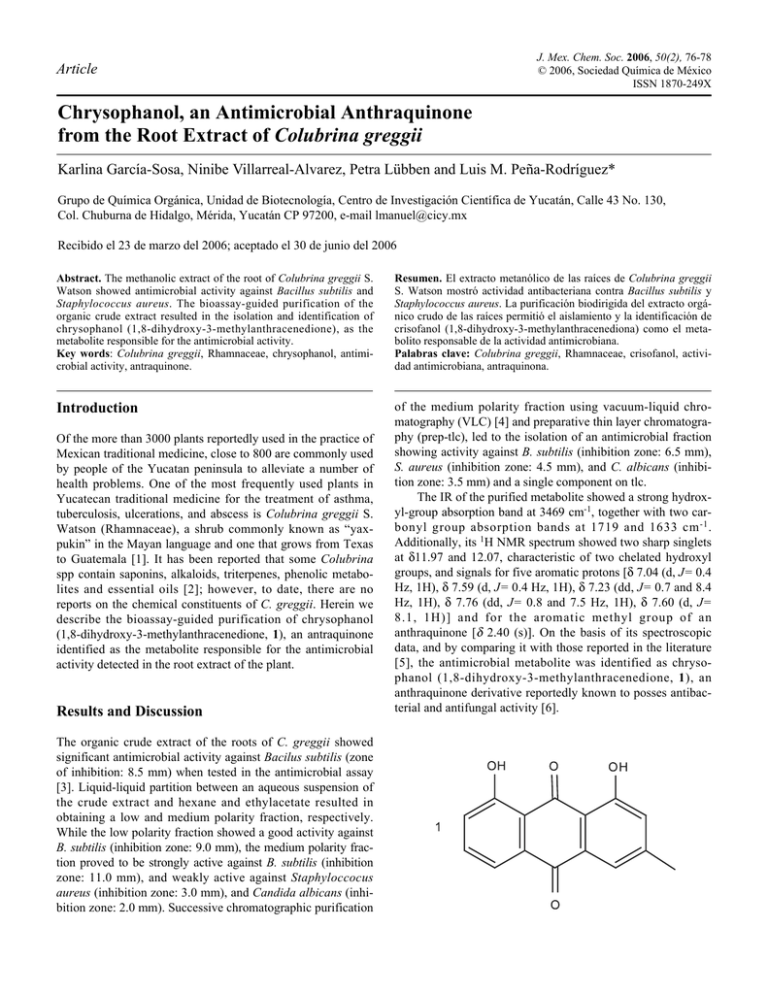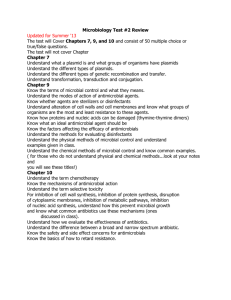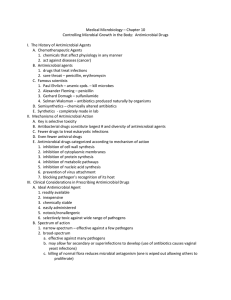Chrysophanol, an Antimicrobial Anthraquinone Colubrina greggii Article
advertisement

J. Mex. Chem. Soc. 2006, 50(2), 76-78 © 2006, Sociedad Química de México ISSN 1870-249X Article Chrysophanol, an Antimicrobial Anthraquinone from the Root Extract of Colubrina greggii Karlina García-Sosa, Ninibe Villarreal-Alvarez, Petra Lübben and Luis M. Peña-Rodríguez* Grupo de Química Orgánica, Unidad de Biotecnología, Centro de Investigación Científica de Yucatán, Calle 43 No. 130, Col. Chuburna de Hidalgo, Mérida, Yucatán CP 97200, e-mail lmanuel@cicy.mx Recibido el 23 de marzo del 2006; aceptado el 30 de junio del 2006 Abstract. The methanolic extract of the root of Colubrina greggii S. Watson showed antimicrobial activity against Bacillus subtilis and Staphylococcus aureus. The bioassay-guided purification of the organic crude extract resulted in the isolation and identification of chrysophanol (1,8-dihydroxy-3-methylanthracenedione), as the metabolite responsible for the antimicrobial activity. Key words: Colubrina greggii, Rhamnaceae, chrysophanol, antimicrobial activity, antraquinone. Resumen. El extracto metanólico de las raíces de Colubrina greggii S. Watson mostró actividad antibacteriana contra Bacillus subtilis y Staphylococcus aureus. La purificación biodirigida del extracto orgánico crudo de las raíces permitió el aislamiento y la identificación de crisofanol (1,8-dihydroxy-3-methylanthracenediona) como el metabolito responsable de la actividad antimicrobiana. Palabras clave: Colubrina greggii, Rhamnaceae, crisofanol, actividad antimicrobiana, antraquinona. Introduction of the medium polarity fraction using vacuum-liquid chromatography (VLC) [4] and preparative thin layer chromatography (prep-tlc), led to the isolation of an antimicrobial fraction showing activity against B. subtilis (inhibition zone: 6.5 mm), S. aureus (inhibition zone: 4.5 mm), and C. albicans (inhibition zone: 3.5 mm) and a single component on tlc. The IR of the purified metabolite showed a strong hydroxyl-group absorption band at 3469 cm-1, together with two carbonyl group absorption bands at 1719 and 1633 cm -1 . Additionally, its 1H NMR spectrum showed two sharp singlets at δ11.97 and 12.07, characteristic of two chelated hydroxyl groups, and signals for five aromatic protons [δ 7.04 (d, J= 0.4 Hz, 1H), δ 7.59 (d, J= 0.4 Hz, 1H), δ 7.23 (dd, J= 0.7 and 8.4 Hz, 1H), δ 7.76 (dd, J= 0.8 and 7.5 Hz, 1H), δ 7.60 (d, J= 8.1, 1H)] and for the aromatic methyl group of an anthraquinone [δ 2.40 (s)]. On the basis of its spectroscopic data, and by comparing it with those reported in the literature [5], the antimicrobial metabolite was identified as chrysophanol (1,8-dihydroxy-3-methylanthracenedione, 1), an anthraquinone derivative reportedly known to posses antibacterial and antifungal activity [6]. Of the more than 3000 plants reportedly used in the practice of Mexican traditional medicine, close to 800 are commonly used by people of the Yucatan peninsula to alleviate a number of health problems. One of the most frequently used plants in Yucatecan traditional medicine for the treatment of asthma, tuberculosis, ulcerations, and abscess is Colubrina greggii S. Watson (Rhamnaceae), a shrub commonly known as “yaxpukin” in the Mayan language and one that grows from Texas to Guatemala [1]. It has been reported that some Colubrina spp contain saponins, alkaloids, triterpenes, phenolic metabolites and essential oils [2]; however, to date, there are no reports on the chemical constituents of C. greggii. Herein we describe the bioassay-guided purification of chrysophanol (1,8-dihydroxy-3-methylanthracenedione, 1), an antraquinone identified as the metabolite responsible for the antimicrobial activity detected in the root extract of the plant. Results and Discussion The organic crude extract of the roots of C. greggii showed significant antimicrobial activity against Bacilus subtilis (zone of inhibition: 8.5 mm) when tested in the antimicrobial assay [3]. Liquid-liquid partition between an aqueous suspension of the crude extract and hexane and ethylacetate resulted in obtaining a low and medium polarity fraction, respectively. While the low polarity fraction showed a good activity against B. subtilis (inhibition zone: 9.0 mm), the medium polarity fraction proved to be strongly active against B. subtilis (inhibition zone: 11.0 mm), and weakly active against Staphyloccocus aureus (inhibition zone: 3.0 mm), and Candida albicans (inhibition zone: 2.0 mm). Successive chromatographic purification Chrysophanol, an Antimicrobial Anthraquinone from the Root Extract of Colubrina greggii Anthraquinone derivatives, usually in the form of glycosides or rhamnosides, are the active components in a number of crude drugs having purgative properties. The presence of the sugar residue is a prerequisite for the pharmacological effects, since the sugar moiety increases the solubility of the molecule and facilitates its transport to the site of action. After oral administration, the antraquinone glycosides or rhamnosides are hydrolyzed in the colon by the enzymes of the microflora; however, the use of anthraquinone-derived drugs should be restricted to short term treatment of constipation, as frequent or long-term use has been associated with an increase in the risk of intestinal tumors [7,8]. The weaker antimicrobial activity of chrysophanol, when tested against B. subtilis, suggests the possibility of a synergistic effect with other metabolites present in the original crude fraction. Materials and Methods General 1H NMR (400 MHz) spectra were recorded on a Bruker Avance 400 apparatus using CDCl3 as a solvent and TMS as internal reference. IR spectra were obtained on a Nicolet Magna Protégé 460 FT-IR instrument, using CHCl3 (Merck, Uvasol) as solvent. Analytical TLC were performed on aluminum sheets impregnated with silica gel 60 F 254 (E.M. Merck, 0.20 mm thickness); chromatograms were examined under UV light (365 and 254 nm) using a UV-viewing cabinet (Spectroline, model CX-20) and visualized by spraying with a 4% phosphomolybdic acid solution containing a trace of ceric sulfate in 5% H2SO4. Preparative TLC (PTLC) was performed on glass plates (20 x 20 cm) impregnated with silica gel 60 F254 (E.M. Merck, 0.5 mm thickness). VLC purification was run using TLC-grade silica gel 60 GF254. Plant material The roots of C. greggii were collected in Abalá, Yucatán in November, 2000; a voucher specimen (P. Simá 2503) representing this collection was deposited in the herbarium of Unidad de Recursos Naturales CICY. 77 Testing of the methanolic crude extract and both crude fractions for antibacterial activity, using the disk diffusion technique, indicated that the medium polarity fraction had the strongest activity against Bacillus subtilis (ATCC-6633). The bioactive fraction 2B (9.8 g) was purified by VLC using a 7.5 cmdiameter column and a gradient elution with CH2Cl2:Hex:MeOH mixtures, to produce twelve fractions. Similar fractions were pooled according to their composition on TLC and the resulting nine major fractions (3A-I) were evaluated for antimicrobial activity. The least polar fraction 3A, showing antimicrobial activity, was further purified by VLC using a gradient elution with CH2Cl2:Hex:MeOH and CH2Cl2:MeOH (90:10) to yield thirteen principal fractions (4A-M). Prep TLC purification of the bioactive fraction 4A (46.9 mg) using multiple elution (3x) with Hex:EtoAc 9:1 resulted in the isolation of 1 (4.7 mg) in pure form. Chrysophanol (1): obtained as an orange oil; 4.7 mg. IR (CHCl3) γmax 3469 (OH), 1633 (chelated-CO), 1719 (esterCO) cm-1; 1H NMR (CDCl3, 400 MHz) δ (ppm) 12.04 (1H, s, OH-8), 11.97 (1H, s, OH-1), 7.76 (1H, dd, J = 0.76 and 7.52, H-5), 7.60 (1H, d, J = 8.1, H-6), 7.59 (1H, d, J = 0.4, H-4), 7.23 (1H, dd, J = 0.74 and 8.4, H-7), 7.04 (1H, d, J = 0.4, H2), 2.40 (3H, s, H-3). Antibacterial assay Bacteria [Bacillus subtilis (ATCC-6633) and Staphylococcus aureus (ATCC-6538)] were kept on soy trypticasein agar at 37 °C for 24 h (parent cultures), while Candida albicans (ATCC-10231) parent cultures were maintained on Sabouraud agar at 37 °C for 24 h. A microbial suspension (0.5 mL) from the parent culture, adjusted to a microorganism concentration of 1 x 108 colony forming units (CFU)/ml, was used to inoculate the surface of the corresponding agar plates. Filter paper disks (Whatman No. 1, USA, 6 mm in diameter) were impregnated with 10 μl of a 5% solution of the extract or fraction to be tested and the disks were allowed to dry at room temperature, before placing them on the agar surface. Cultures were then incubated at 37°C for 24 h; antibacterial activity was determined measuring the inhibition zone around the disk. The values reported were determined by measuring the distance from the edge of the paper disk to the limit of the inhibition zone. Amikacin was used as positive control in all cases. Extraction and isolation The dried roots of C. greggii (287.6 g) were ground and extracted three times with MeOH (2 L) at room temperature. The solvent was filtered and evaporated under reduced pressure to give 63.1 g of organic crude extract 1A (yield: 21.9 %). The extract was suspended in a mixture of H2O/MeOH (3:2, 1.5 L) and the resulting aqueous suspension was partitioned successively with hexane and ethyl acetate to produce the corresponding low (2A, 2.8 g, 4.4%) and medium (2B, 9.8 g, 15.5%) polarity crude fractions. References 1. Mendieta, R. M.; Del Almo, S. Plantas Medicinales del Estado de Yucatán, 1ª Ed. Compañía Editorial Continental, 1981, 110. 2. Xing-Cong, L.; Hala, N. E.; Alison, C. N.; Alice, M. C. J. Nat. Prod. 1999, 62, 674-677 3. Vera-Kú, B. M. “Evaluación de la Actividad Biológica en Plantas Medicinales Nativas de la Península de Yucatán” Tesis de Maestría, Centro de Investigación Científica de Yucatán, 2004, Mérida, Yucatán, México. 78 J. Mex. Chem. Soc. 2006, 50(2) 4. Coll, J. C.; Bowden, B. F. J. Nat. Prod. 1986, 49, 934-936. 5. Pei-Lan, D; Ai-Jun, H.; Dao-Feng, C. J. Asian Nat. Prod. Res., 2005, 7, 237-243. 6. Suresh, B. K.; Srinivas, P. V.; Praveen, B.; Hara, K.,K.; Surynarayana, M. U.; Madhusudana, R. J. Phytochemistry. 2003, 62, 203-207. Karlina García-Sosa et al. 7. Robber, J. E.; Speedie, M. K.; Tyler, V. E. Pharmacognosy and Pharmacobiotecnology. William and Wilkin Co. 1996. 51. 8. Samuelsson G. Drugs of Natural Origin, 4a Ed. Apotekarsocieteten. 1999, 190-194.






